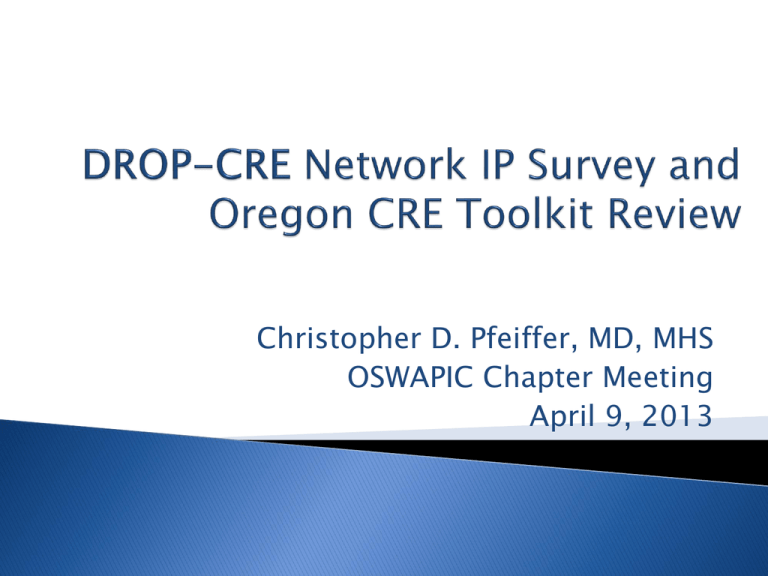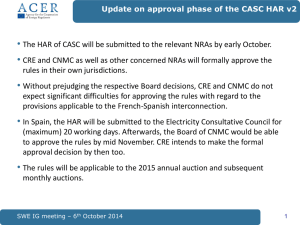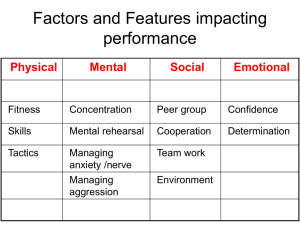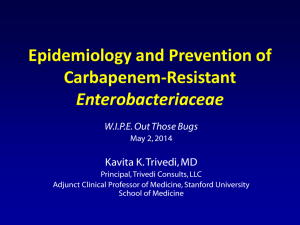DROP-CRE - OSWAPIC
advertisement

Christopher D. Pfeiffer, MD, MHS OSWAPIC Chapter Meeting April 9, 2013 Learn about the newly established DROP-CRE Network. Review results of the DROP-CRE Infection Prevention Survey on MDRO practices. Review the updated Oregon CRE Toolkit with a focus on understanding the Oregon CRE definition and Infection Preventionists’ role in CRE prevention and control. CRE Initiated September 2012 Zintars Beldavs, MS (OHA) Genevieve Buser, MD (OHA) Margaret Cunningham, MPH (OHA) Tasha Poissant, MPH (OHA) Ann Thomas, MD, MPH (OHA) Jon Furuno, PhD (OSU College of Pharmacy) Chris Pfeiffer, MD, MHS (PVAMC, OHSU) John Townes, MD (OHSU) Dianna Appelgate, MS, MPH, CIC (Sacred Heart, Springfield) Avanthi Doppalapudi, MD (Providence, Medford) Ronald Dworkin, MD (Providence, Portland) Kendra Gohl, RN, BSN, CIC (Columbia, Astoria) Alex Kallen, MD, MPH (CDC, Atlanta GA) Margret Oethinger, MD, PhD (Providence, Portland) Robert Pelz, MD, PhD (PeaceHealth, Springfield) Kathy Phipps, RN, BSN, CPUR (Acumentra, Portland) Mary Post, RN, MS, CNS, CIC (OPSC, Portland) Pat Preston, MS (McMinnville) Sheryl Ritz, RN, BSN (Vibra, Portland) Susan Sharpe, PhD, DABMM, FAAM (Kaiser, Portland) Sarah Slaughter, MD (Providence, Portland) Cathy Stone, MT, CIC (Good Sam, Corvallis) 1. 2. 3. 4. 5. Assess statewide needs and capabilities for MDRO/CRE response. Coordinate statewide CRE education. Develop capacity for rapid carbapenemase identification. Offer real-time epidemiologic outbreak assistance to Oregon facilities with CRE. Track CRE regionally between facilities. IP Needs Assessment Survey Results 45/62 (72%) responded Response rate by bed size ◦ ◦ ◦ ◦ 5-49 beds: 21/29 (72%) 50-99 beds:4/6 (66%) 100-149 beds: 9/10 (90%) >150 beds: 8/13 (61%) Resistant to at least 3 classes of 25% antimicrobials 41% Resistant to at least 2 classes of 28% 6% antimicrobials Susceptible to only 2 classes of antimicrobials Other Are β-lactams and cephalosporins considered to be in the “same class”? Yes 9%; Unsure 21%, No 70% Patients placed in contact precautions: ◦ CRE: 85% ◦ ESBL: 73% ◦ MDR-Pseudomonas spp. : 69% ◦ MDR-Acinetobacter spp. : 76% ◦ MRSA/VRE: 97% ◦ C. diff: 100% Activities monitored: ◦ Hand hygiene: 91% ◦ Isolation precautions: 79% ◦ Environmental cleaning: 85% Most UV fluorescence marker or ATP monitor ◦ None: 3% 58% strongly agree or agree that their facility is aware of patients’ MDRO status upon admission 82% a strongly agree or agree that a receiving facility is made aware of patients’ MDRO status upon discharge 15% listed CRE amongst top 3 MDRO priorities ◦ 97% MRSA and Cdiff; 61% VRE; 42% ESBL 94% aware of CDC CRE Toolkit 79% used the OHA CRE definition stated on the survey (21% were unsure) 18/33 (55%) had not reviewed microbiology records to detect unrecognized CRE cases ◦ Of those who had reviewed, 20% (3/15) identified CRE. No facility had conducted a CRE point prevalence survey Extremely valuable: ◦ Teleconference with experienced epi team during CRE outbreak/exposure 67% ◦ APIC presentation 55% ◦ Site visit with experienced epi team during CRE outbreak/exposure 55% ◦ Webinar 49% ◦ Educational handouts/algorithms 44% ◦ Grand Rounds at your hospital 16% Moderately or Not Valuable 68% Definitions of MDRO-GNR vary widely IPs are often not confident whether MDRO status of patients is communicated in transfer ~50% of facilities have reviewed microbiology records for CRE Facilities are frequently monitoring adherence to contact precautions (79%), hand hygiene (91%), and environmental cleaning (85%). Thanks again to all survey participants! Oregon CRE Toolkit Photos from CDC CRE Toolkit 2012 1. Overview of the Toolkit 2. Definition 3. 4. 5. 6. 7. 8. Infection Prevention/Control in Acute Care Facilities Infection Prevention/Control in Long Term Care Facilities Infection Prevention/Control in Ambulatory Care Settings Microbiology Laboratories: Detection and Reporting References Appendices (CRE Interfacility transfer form, CDC environmental cleaning monitoring tool, Screening culture laboratory protocol and sample letter for staff and patients, Basic and Advanced CRE FAQ, Patient Safety Tips) Enterobacteriaceae that… Are non-susceptible (i.e., intermediate or resistant) to ANY carbapenem (e.g., doripenem, ertapenem, imipenem, or meropenem) AND resistant to ANY of the following 3rd generation cephalosporin tested: cefotaxime, ceftriaxone, or ceftazidime —OR— Possess/contain a gene sequence specific for carbapenemase (PCR) —OR— Are positive for carbapenemase by a phenotypic test (e.g., Modified Hodge Test) Organisms Included Recommended Action 1 Carbapenemaseproducing CRE •All PCR+ •MHT+ EXCEPT Enterobacter spp. Most aggressive control measures 2 CRE with acquired carbapenem resistance NOT due to carbapenemase production •CRE that do not qualify as either Tier 1 or Tier 3 •Includes MHT+, PCR negative Enterobacter spp. Facility-level control measures CRE with intrinsic (natural) imipenem Proteus, Providencia and Morganella spp. with ONLY No special control measures Tier 3 Description imipenem non-susceptibility Understanding Enterobacteriaceae. CRE: “non-susceptible” or “resistant”? Low adoption rate of new CLSI breakpoints of Enterobacteriaceae to carbapenems. Inability to rapidly identify the resistance mechanism (carbapenemase vs. other). 1. 2. 3. 4. ◦ And, does resistance mechanism matter for infection control? Gram negative bacilli (rods) mostly found in the gastrointestinal tract Laboratory basics: all ferment glucose, mostly oxidase negative Examples: ◦ Main: E. coli, Klebsiella spp., Enterobacter spp. ◦ Other: Proteus spp., Providencia spp., Morganella spp., Citrobacter spp., Serratia spp., Salmonella spp. Pseudomonas spp. and Acinetobacter spp. are NOT Enterobacteriaceae. Old Breakpoints (µg/mL) (through Jan. 2010; M100-S19) New Breakpoints (µg/mL) (revised Jun. 2010 and Jan. 2012; M100-S22) S I R S I R Doripenem n/a n/a n/a ≤1 2 ≥4 Ertapenem ≤2 4 ≥8 ≤0.5 1 ≥2 Imipenem ≤4 8 ≥16 ≤1 2 ≥4 Meropenem ≤4 8 ≥16 ≤1 2 ≥4 1. 2. Carbapenemase (Tier 1) Non-Carbapenemase (Tiers 2 & 3) Routine susceptibility testing in the microbiology laboratory does not reliably differentiate the resistance mechanism. Carbapenemases directly inactivate carbapenems CP CRE are primarily responsible for rapid worldwide spread of CRE. ◦ “plasmid mediated” transmission ◦ Klebsiella spp. most common Carbapenemases to know: ◦ ◦ ◦ ◦ ◦ Klebsiella pneumoniae carbapenemase (KPC) New Delhi metallo-β-lactamase (NDM) Verona integron encoded metallo-β-lactamase (VIM) Imipenemase metallo-β-lactamase (IMP) Oxacillinase-48 (OXA-48). Resistance mechanism is typically: ◦ extended spectrum β-lactamase (ESBL) or extended spectrum cephalosporinase (e.g. AmpC) plus ◦ decreased permeability of the cell wall (e.g. porin mutation). Epidemiology: ◦ stable over time ◦ Most often seen in Enterobacter spp. Local (i.e. unit- or facility-wide) rather than global impact. Using “new” CLSI breakpoints, it is common to encounter imipenem non-susceptible organisms (MICs 2–4 µg/mL) that were considered susceptible by the “old” CLSI breakpoints. Proteus spp., Providencia spp., and Morganella spp. ◦ PVAMC Antibiogram: Morganella morganii 2009 2010 2011 2012 100% imi-S 100% imi-S 20% imi-S 34% imi-S Non-susceptibility to any other carbapenem is unusual and reason for concern. Gupta et al. Clin Infect Dis 2011;53:60-67 Gupta et al. Clin Infect Dis 2011;53:60-67 Nordmann et al. Emerg Infect Dis 2011;17:1791-98 Nordmann et al. Emerg Infect Dis 2011;17:1791-98 Slide from Alex Kallen,MD, MPH) DC KPC KPC, NDM HI PR AK Patel, Rasheed, Kitchel. 2009. Clin Micro News MMWR MMWR Morb Mortal Wkly Rep. 2010 Jun 25;59(24):750. MMWR Morb Mortal Wkly Rep. 2010 Sep 24;59(37):1212. CDC, unpublished data KPC, NDM, OXA KPC, NDM, VIM KPC, NDM, VIM, IMP 45 CRE 3 KPC No NDM No other known carbapenemases * * CRE reported *KPC-producing CRE reported * Number reported Modified Hodge Test Positive PCR positive for KPC Enterobacter aerogenes No. 5 No. (%) 3 (60) No. (%) 0 Enterobacter cloacae Enterobacter spp. Escherichia coli Klebsiella pneumoniae 25 1 2 9 16 (64) 0 n/a 4 (44) 0 0 0 3 (33%) Proteus mirabilis Citrobacter spp Serratia marcescens 1 1 1 45 n/a 1 (100) 0 24 (53) 0 0 0 3 (7%) Organism Total Different than the other carbapenems ◦ No activity against Pseudomonas aeruginosa ◦ Slightly weaker activity against Enterobacteriaciae Lowest barrier to resistance via ESBL/AmpC + porin change ◦ Typical use in practice: outpatient antibiotic therapy In the lab: the most sensitive but least specific carbapenem used to screen for CRE. ◦ For labs using the “Old” CLSI breakpoints: ertapenem non-susceptibility may be the only indicator of CP CRE. 39/48 (81%) labs responded CRE screening methods (n=37) ◦ 25 labs: automated testing only (Microscan or Vitek) 7/25 use new CLSI breakpoints ◦ 3 labs: both automated and manual testing ◦ 9 labs: manual testing only 3/9 use new CLSI breakpoints Confirmatory carbapenemase testing ◦ 7/37 use Modified Hodge Test 5/7 use new CLSI breakpoints We are encouraging labs to either A) Switch over to new breakpoints; or B) Perform Modified Hodge Testing. If not possible, send isolates meeting screening criteria (carbapenem MIC ≥2 and resistance to any 3rd generation cephalosporin) to OSPHL for MHT Carbapenemases not only directly hydrolyze carbapenems but also penicillins and cephalosporins Addition of 3rd generation (IV) cephalosporins to the definition ◦ Improves specificity ◦ Does not sacrifice (much) sensitivity ◦ Increases complexity Cefepime: 4th gen cephalosporin; NOT included in the CRE definition Indirect phenotypic test of carbapenemase production. Accuracy: ◦ Great: KPC detection in E. coli and Klebsiella spp., ◦ BAD: KPC detection in Enterobacter spp. >50% of Enterobacter spp. CRE in Oregon are MHT+ (all are PCR neg) ◦ Variable/Uncertain: non-KPC carbapenemases Carbapenemase PCR (or other genotypic method) is the most accurate way to detect CP CRE. Carbapenemase PCR testing is currently not widely available. ◦ No private labs performing the test in Oregon We anticipate PCR to be online at OSHPL in May Enterobacteriaceae that… Are non-susceptible (i.e., intermediate or resistant) to ANY carbapenem (e.g., doripenem, ertapenem, imipenem, or meropenem) AND resistant to ANY of the following 3rd generation cephalosporin tested: cefotaxime, ceftriaxone, or ceftazidime —OR— Possess/contain a gene sequence specific for carbapenemase (PCR) —OR— Are positive for carbapenemase by a phenotypic test (e.g., Modified Hodge Test) 1st mandated Dec, 2011 Laboratories and clinicians required to report Report all CRE using the revised CRE case definition Labs are asked to submit a subset of isolates for further testing at OHA and CDC OSPHL will perform in real-time: MHT (available now) and PCR for KPC and NDM (available soon) 2. Overview of the Toolkit Definition 3. Infection Prevention/Control in Acute Care Facilities 1. 4. 5. 6. 7. 8. Infection Prevention/Control in Long Term Care Facilities Infection Prevention/Control in Ambulatory Care Settings Microbiology Laboratories: Detection and Reporting References Appendices (CRE Interfacility transfer form, CDC environmental cleaning monitoring tool, Screening culture laboratory protocol and sample letter for staff and patients, Basic and Advanced CRE FAQ, Patient Safety Tips) Educate staff (CRE and other MDR-GNRs) Communicate with your microbiology lab ◦ ◦ ◦ ◦ Use the OHA CRE definition Ensure IPC is notified when CRE is detected Know which CLSI breakpoints are used at your facility Review past 12 months of lab records for previously unrecognized CRE Consider active surveillance cultures for CRE colonization in select patients on admission Notify Local Health Dept. Assess “Tier” of CRE; act accordingly Follow the “NICE” Toolkit Recommendations Notify: ◦ Local health department, clinician groups (ID, ICU, etc.), antibiotic stewardship program ◦ For CP-CRE: Notify hospital administration Intervene ◦ Emphasize core strategies: hand hygiene, Contact Precautions, private rooms, environmental cleaning ◦ Reduce unnecessary antibiotics ◦ Reduce use of invasive devices ◦ For CP CRE: screen patient contacts; cohort staff/patients Communicate CRE status to any receiving facility Educate patients, staff, and visitors about CRE 2. Overview of the Toolkit Definition 3. Infection Prevention/Control in Acute Care Facilities 1. 4. 5. 6. 7. 8. Infection Prevention/Control in Long Term Care Facilities Infection Prevention/Control in Ambulatory Care Settings Microbiology Laboratories: Detection and Reporting References Appendices (CRE Interfacility transfer form, CDC environmental cleaning monitoring tool, Screening culture laboratory protocol and sample letter for staff and patients, Basic and Advanced CRE FAQ, Patient Safety Tips) 2 CRE FAQs CDC Vital Signs OSTLTS PHPSF General Patient Safety Tips Eventually we plan to add more material to OHA CRE Website including talks and slidesets Dr. Alex Kallen’s CityWide ID presentation on CRE Feb 14, 2013 is linked below: ◦ https://www.eventbuilder.com/providence/event_d esc.asp?z=506275&p_event=r4i8b8z3 What else would be helpful? The newly established DROP-CRE Network is positioned to support Infection Preventionists efforts in MDROs/CRE prevention and control. The IP Survey indicates room for improvement in regional CRE prevention and control. CRE in Oregon ◦ The Oregon CRE definition has been established. ◦ CRE are currently rare. ◦ Our particular focus is preventing spread of carbapenemase-producing CRE around the region. ◦ Use the OR CRE Toolkit as a resource for CRE prevention control at your facilities.








